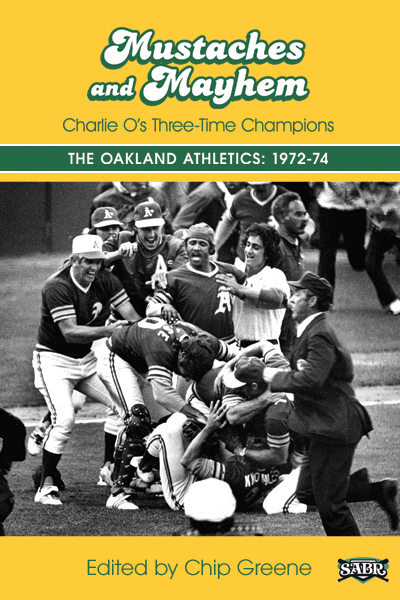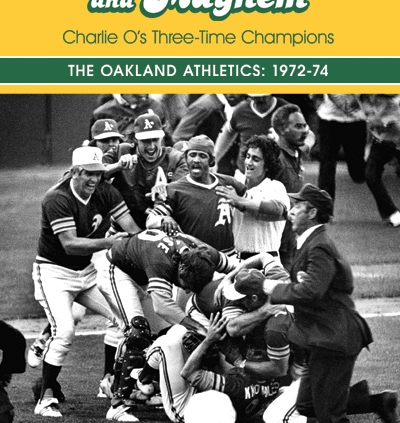Introduction: Mustaches and Mayhem: Charlie O’s Three-Time Champions: 1972-74 Oakland Athletics
This article was written by Nelson ‘Chip’ Greene
This article was published in 1972-74 Oakland Athletics essays
 In 1976, Reggie Jackson, then arguably baseball’s biggest superstar, joined my favorite team, the Baltimore Orioles, in a trade from the Oakland A’s. Accompanying him was gritty left-handed pitcher Ken Holtzman. Coming a year after the shocking change of teams from the A’s to the Yankees by free-agent pitcher Catfish Hunter, the trade brought excitement to Baltimore in equal measure with what was assuredly disgust on the part of A’s fans. For Hunter, Jackson, and Holtzman had been integral pieces of Oakland’s three consecutive championships, and now each was gone. It was just the beginning of the dismantling of one of the premier teams in baseball history.
In 1976, Reggie Jackson, then arguably baseball’s biggest superstar, joined my favorite team, the Baltimore Orioles, in a trade from the Oakland A’s. Accompanying him was gritty left-handed pitcher Ken Holtzman. Coming a year after the shocking change of teams from the A’s to the Yankees by free-agent pitcher Catfish Hunter, the trade brought excitement to Baltimore in equal measure with what was assuredly disgust on the part of A’s fans. For Hunter, Jackson, and Holtzman had been integral pieces of Oakland’s three consecutive championships, and now each was gone. It was just the beginning of the dismantling of one of the premier teams in baseball history.
With the advent of free agency looming, other stars soon found themselves headed out of Oakland. In June 1976 Commissioner Bowie Kuhn tried to stem the tide of an Oakland housecleaning when he blocked the proposed sale of former Cy Young award winner Vida Blue to the Yankees for $1.5 million as well as that of star left fielder Joe Rudi and relief ace Rollie Fingers to the Red Sox for $2 million. As it turned out, Kuhn was only delaying the inevitable. The breakup of the three-time champions occurred with lightning speed.
For five years the Oakland A’s had been a glorious franchise. Built from the inside out, with a stable of young homegrown talent who had matured together in the minor leagues, from 1971 through 1975, Oakland won five consecutive American League West titles, winning it all in the middle three of those seasons. In the process, the core starting lineup of Bando at third; Campaneris at short; Green at second; Rudi in left; Jackson in right; Tenace catching or playing first; and Hunter, Odom, and Fingers on the mound, together with such imports as Holtzman and Bill North, took the field and withstood both their own internal squabbling and one of the most notorious owners the game has ever known to defeat all comers and permanently etch their names as one of the greatest teams ever assembled.
Their common foe was always Charles Oscar Finley. If the A’s players sometimes fought with one another as well as their opponents, the bond most of them shared was a loathing of the A’s irascible, overbearing, pompous, manipulative, scheming, cantankerous, bombastic, often prevaricating, but flamboyant, creative, forward-thinking, and inventive owner. Indeed, so frequently did Finley meddle in the affairs of his team, so often did he commit some seemingly egregious offense against one or another player, that the result became a shared commitment among the A’s personnel to band together against Finley’s dictates and misbehavior and denounce him as an abhorrent and often juvenile cheapskate and a louse. Finley became the unifying negative force in the locker room (not that he ever really minded, if it meant his team would win) and the players took that camaraderie to the field and won in spite of his churlish behavior.
This book chronicles the lives and times of those men and those teams. Included is a biography of each player who appeared in an Oakland uniform in each of the three championship years, together with the managers, coaches, Finley himself, and Monte Moore, who broadcast the games. As baseball seasons begin with spring training and end with the World Series, so too is each season here similarly recapped, in chronological order, with the men who joined the team in a particular season included in that year’s account. Documenting multiple seasons was, of course, a major undertaking, and would not have been accomplished without the dedication and able writing of a number of SABR volunteers, each of whom I sincerely thank and whose excellent work speaks for itself in the pages that follow.
Beyond the outstanding writing, however, I extend my heartfelt appreciation to an editorial team which for the better part of two years read every word and checked every fact to ensure that we got it right. In particular, this book would not have been produced without the commitment of Bill Nowlin, Len Levin, and Greg Erion. For their assistance, I am eternally indebted.
— Chip Greene
Waynesboro, Pennsylvania
November 29, 2014
Related links


